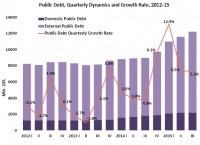Issue 60: Public Debt – I-III Quarters, 2015


|
Public Debt – I-III Quarters, 2015
Issue #60 / 20.11.2015
|
||
|
In the first three quarters of 2015, compared to the indicator of 2014, the external public debt declined by 0.1%, while the corresponding indicator in GEL increased (27.7%), this is attributable to changes in the exchange rate. Hence, the public debt increased by 25.5%. Compared to 2014, the indicator of domestic debt also increased by 16.5%. In this period, the Government of Georgia’s three largest multilateral creditors were: International Development Association (IDA) – 41.7%; International Bank for Reconstruction and Development (IBRD) – 20.9%; and Asian Development Bank (ADB) – 16.4%. The largest bilateral creditors are Germany (38.1%), Japan (22.2%) and Russia (12.3%).
|
||
|
|
During the first three quarters of 2015, the volume of public debt increased by 2 478 mln GEL (25.5%) compared to the corresponding indicator of 2014. In this period, 81.9% of the public debt was external debt. The share of external public debt in public debt exceeds the indicator of 2014 by 1.4% point. The indicator of external debt in GEL increased by 17.7%. Such a significant increase of external public debt in GEL is due to the fluctuation in the exchange rate, as in this period external public debt in USD declined by 0.1%. During the first three quarters of 2015, the share of domestic public debt in the public debt was 18.1%. Even though the volume of domestic public debt increased by 16.5% in this period compared to 2014, its share in public debt declined by 1.4% point, which can be explained by the fact that the indicator of the external public debt increased more, due to the exchange rate effect, than the indicator of domestic public debt.
|
|
|
Public debt-to-GDP ratio is an important indicator to measure fiscal sustainability in the country. The critical threshold of this parameter, defined by the International Monetary Fund (IMF), is 50% for developing countries. In the first three quarters of 2015, public debt to nominal GDP (forecast) ratio is 38.7%. This indicator compared to 2014 increased by 5.4% point, but is below the critical threshold set by the IMF (50%). During the first three quarters of 2015, compared to 2014, the indicator of external public debt to-nominal GDP (forecast) increased by 7.4% point and amounted to 34.2%.
.
|
|
|
|
|
Public debt-to-budget revenues ratio is another important parameter. The critical threshold of this parameter for developing countries, defined by the IMF, is 300%. During the first three quarters of 2015, public debt-to-budget revenues ratio is 202.5%, this indicator increased significantly compared to 2014 (71.7% point) but does not exceed the critical threshold. During the first three quarters of 2015, compared to 2014, external public debt-to-budget revenues ratio increased by 60.5% point to reach 165.8%.
|
|
|
Another important indicator to measure fiscal sustainability is public debt-to-export ratio. The critical threshold for developing countries, set by the IMF, is 200%. During the first three quarters of 2015, public debt-to-export ratio is 310.0%, while external public debt-to-export ratio is 253.9%, both of which exceed the critical threshold. From 2009 to 2013, this indicator was in decline, but was still exceeding the critical threshold set by the IMF except in 2013 (173.4%) and in 2014 (180.3%).
|
|
|
|
|
|
|
| Source: Ministry of Finance of Georgia International Monetary Fund
During the first three quarters of 2015, the indicator of public debt service-to-export ratio is 14.7%, which does not exceed the critical threshold of this parameter defined by the IMF (25%). In the period of 2009 to 2014, the annual indicator exceeded the critical threshold only once, in 2009 when it reached 27.1%. The lowest rate of this indicator (9.8%) was observed in 2012. During the first three quarters of 2015, the indicator of public debt service-to-budget revenues was 9.6%. In this period, this indicator did not exceed the critical threshold of this parameter defined by the IMF (35%).
|
||
|
|
||
 |
||
 Source: Minisrty of Finance of Georgia
Source: Minisrty of Finance of Georgia




